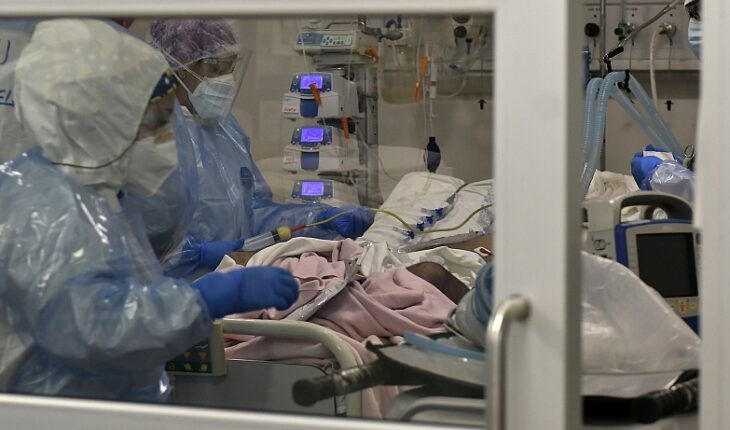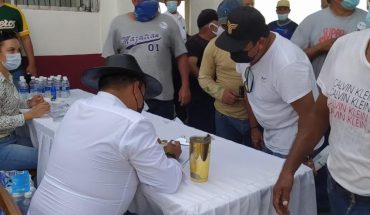The ICOVID Chile team, an initiative led by the University of Chile, the Pontifical Catholic University of Chile and the University of Concepción, presented its 70th report with analysis and data of the proposed dimensions to monitor the pandemic in the country, with information obtained until Saturday, January 8, 2022, provided through an agreement with the Ministry of Health and the Ministry of Science, Technology, Knowledge and Innovation.According to the new report, the indicator of burden of infected people, which measures the average of new daily cases of the last week per 100 thousand inhabitants, reached in the last week to 24.82 nationwide, compared to 8.68 of the previous week. “The above values indicate that new cases almost tripled during the last week. It is the highest weekly growth rate recorded in the statistics that ICOVID has collected throughout the pandemic (these begin on April 2, 2020),” the report reads. At the regional level, meanwhile, the highest values are in Tarapacá (191.2), Arica and Parinacota (122.2) and Magallanes (98.0). Tarapacá’s load level this week is the highest reached at the regional level during the entire pandemic. The expert in statistics and academic of harvard University, José Zubizarreta, warned that “omnicron accelerates in our population. Cases have increased exponentially. The remedy? Vaccination, masks, restraint. Caring for ourselves and others, so that we can flatten and reduce the impact of this new and larger wave.” With respect to the rate of transmission, the effective reproductive number R, which measures the number of people infected, on average, each infected person, rose from 1.14 to 1.64 nationwide. This value is the highest recorded by ICOVID during the pandemic. Locally, R values significantly greater than 1 are observed in all regions, in fact, the estimated value is greater than 1.40 in eleven regions. The highest values are those of Arica and Parinacota (2.71), Magallanes (2.31), Tarapacá (2.08) and Antofagasta (2.05), being the highest observed at the regional level throughout the pandemic. Faced with the national situation, the engineer and academic of the Faculty of Economics and Business of the University of Chile, Eduardo Engel, said that “the ómicron variant has arrived in Chile. New cases nationwide nearly tripled in the past week and the R reached its highest value during the entire pandemic. There is no increase in hospitalizations, although this could change in the coming weeks. It is important to have the complete vaccination schedule and the booster dose, in addition to maintaining preventive measures.” On the testing dimension, the positivity at the national level was 4.39%, higher than the value of 2.97% of the previous week, approaching the orange color at the ICOVID traffic light. Meanwhile, at the regional level, four regions have a positivity above 5%: Tarapacá (13.2%), Magallanes (5.90%), La Araucanía (5.59%) and Arica and Parinacota (5.29%). In the same vein, at the national level, there is an increase in the number of tests carried out, reaching 17.91 tests per thousand inhabitants on a weekly average, compared to 15.84 the previous week. As this increase is accompanied by greater positivity, it can be concluded that the increase in load and the estimated R is not related to an increase in the tests performed. In this same line, the academic of the School of Public Health of the University of Chile, Mauricio Canals, emphasized that “we are entering a new stage, with the ómicron variant changing the entire panorama. Large increase in the number, transmission and positivity of cases. Although the burden has reached 24.8 per hundred thousand inhabitants, there is no impact on general hospitalizations or ICUs. The best defense is to be vaccinated and continue with personal protection measures. However, we must be alert to the impact on the health system of the large increase in cases.” As for traceability, early consultation, an indicator that records the proportion of people who had a medical consultation in two days or less since they started symptoms. has fluctuated between 50% and 60% so far this year. In the last week with available data, this indicator registered a value of 58% at the national level, but with differences across regions. With a positive performance, the regions of Arica and Parinacota stand out along with Atacama, with 84% and 71%, respectively. On the other hand, with a negative performance, are the regions of Coquimbo and Valparaíso with 55% and 53%, respectivamente. With regard to the examination and laboratory time indicator, which records the percentage of tests that were reported to the Ministry of Health in a day or less since the medical consultation, has exceeded the threshold of 80% in the last five weeks nationwide. Thus remaining in green at the ICOVID traffic light, which is good news. In the last week with available data this indicator took a value of 88% at the national level. Meanwhile, “at the regional level, the highest values were found in Atacama and Maule with 97% and 98%, respectively, while the lowest were in Tarapacá and Coquimbo, with 70% and 71%, respectively, which should improve,” they say in the report. On the early confirmation of cases, an indicator that aggregates the times of early consultation and laboratory, and is defined as the proportion of suspicious symptomatic people whose test laboratory result is reported to the health authority within three days from the date of onset of symptoms, this reached 65% nationwide. In Arica and Parinacota, and in Atacama, the highest values were recorded, with 81% and 80%, respectively, while the lowest values in the country were observed in Coquimbo and Valparaíso, with 51% and 59%, respectively. Meanwhile, on the dimension of hospital capacity, this latest report reveals that ICU occupancy has remained stable in the last two weeks: 87.6% this week and 87.7% the previous week. In the regions, occupancy varies between 45% in Aysén and 97.2% in Atacama. The highest occupations are in Atacama, Los Lagos (94.5%), Valparaíso (93.1%), Coquimbo (92.1%), Antofagasta (90.2%) and the Metropolitan Region (90.2%). As for the indicator of use of ICU beds by patients with covid-19, this decreased slightly in the last week, going from 24.9% to 23.3%: in the regions it varies between 10% in Arica & Parinacota and 47.8% in Los Lagos. Likewise, the weekly variation rate in covid-19 hospitalizations, which measures the trend in hospital demand for covid-19 patients, still presents downward values, with a decrease of -3%. Finally, the report points out that the coverage of covid-19 vaccination according to age groups, the proportion of vaccinated with a dose in the groups of over 70 years, between 50 and 69 years, between 18 and 50 years, and under 18 years, reached values of 92.7%, 95.1%, 87.9%, and 73.3% respectively. In parallel, the proportion of vaccinated with two doses registered values of 91.7%, 94.2%, 85.5% and 62.5%, respectively. “Clearly, in the group of children under 18, there is enough room to continue improving and protecting,” the researchers close in the report.
ICOVID team confirms that Chile is currently facing the period with the highest increase in new cases
January 15, 2022 |





